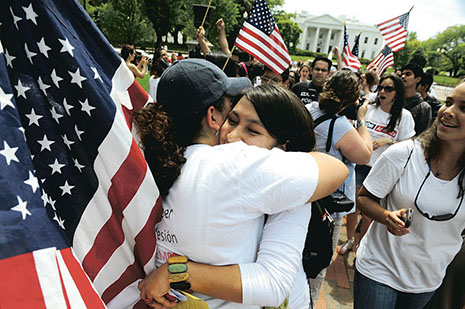IN A swift and remarkable shift, African Americans no longer make up the majority of the population here in Washington DC, a city that prides itself on being a hub of black culture. After dominating the capital’s demographics for fifty years, many have left for surrounding suburbs in Virginia and Maryland.
This demographic change is mainly a result of the gentrification that has transformed downtown Washington. Whites have moved into downtown loft apartments in what were once predominantly black parts of town – neighbourhoods that until recently were no-go zones of crimes and violence, but that have grown safer and vibrant with restaurants and nightlife. Poorer African Americans have moved because of rising housing prices; the more well-to-do are looking for better schools and community facilities.
This phenomenon is part of the picture of race and ethnicity that has emerged from the 2010 US census results, which reveal that the nation as a whole is at a pivotal demographic point. At the end of the first decade of the twenty-first century, the United States is in transition from being a largely white-and-black nation experiencing robust population growth to a nation with an ageing white population, rapidly growing new minorities and a sharply altered geography for African Americans. These demographic changes have implications for voting patterns, the labour force and generational divides, and could shape the nation’s future more than any other factor.
In the decade since the last census, 27.3 million people were added to the US population, but only 9 per cent of them were non-Hispanic whites. Hispanics account for well over half of the population gain, and one in six Americans – fifty million people – is Hispanic. Asians, meanwhile, led all groups in population growth.
The new data show a wave of African Americans leaving the cities for the suburbs, and a surge in multiracial families. The ageing non-Hispanic white population will contribute nothing to population growth after 2030; by 2040 the minority populations will have become the majority.
The statistics on the child population reveal perhaps the most important part of the demographic pivot. The census reveals an absolute decline in the number of white young people over the first decade of this century, and a somewhat smaller decline in the number of black young people. Hispanic, Asian and multiracial children account for all of the net growth in the nation’s under-eighteen population.
The growth in minority populations looms large locally as well as nationally. This is the case not just for the traditional melting-pot states such as Florida, Hawaii and California, but also for states such as Pennsylvania and Nebraska, which now depend on new minority growth for their demographic survival.
There has also been a sharp change in the demographics of the African-American population. The signature patterns of movement that characterised African Americans last century – the migration from south to north, and large concentrations in segregated city neighbourhoods – are undergoing a reversal. Economic progress, cultural ties and an emerging black middle class have driven greater numbers of younger African Americans to leave for prosperous southern metropolitan areas in states such as Georgia and Texas.
Alongside this movement is a black flight from the inner city to the suburbs. The number of African-American residents declined in nineteen of the thirty biggest cities with the largest black concentrations. African Americans with fewer ties to the segregated city neighbourhoods of their parents and grandparents have followed earlier generations of whites to suburbia. These losses were steepest in the largest northern black magnet cities of the past, like Detroit and Chicago, but also occurred in southern cities like Dallas and Atlanta.
About nine million Americans now describe themselves as multiracial, 25 per cent more than in 2000. This reflects a growing number of interracial marriages and the desire of people to acknowledge their full racial and ethnic heritage. Young multiracial Americans are one of the fastest-growing demographic groups in the country and they highlight the fact that racial lines are blurring for a growing number of people.
The new census figures will play an important role in the contentious process of redrawing each state’s political districts according to population and racial make-up. Ten states have lost congressional seats and eight have picked up seats; the upshot, analysts believe, will be more Hispanic-majority districts. Most of the states gaining seats – including Texas and Florida – are Republican leaning, even though their growth is driven by Democrat-leaning Hispanics.
The Hispanic population’s political clout will become increasingly important. In the past decade, the adult Hispanic population has nearly doubled in Nevada, Virginia and North Carolina, and has increased by 60 per cent in Indiana and Ohio, midwestern battleground states. This has led some to conclude that the road to the White House in 2012 may well go through the Hispanic community. In 2008, Barack Obama won the vote of two out of three Hispanics.
In the years ahead, the real divide may end up being along income levels. The nation’s poverty rate is climbing and one in three minority children live in poverty. The income gap between the richest and poorest Americans grew last year to its largest margin ever. A failure to invest in education and healthcare will limit individual economic opportunities, result in reduced national productivity and competitiveness, and potentially lead to civil unrest. •




